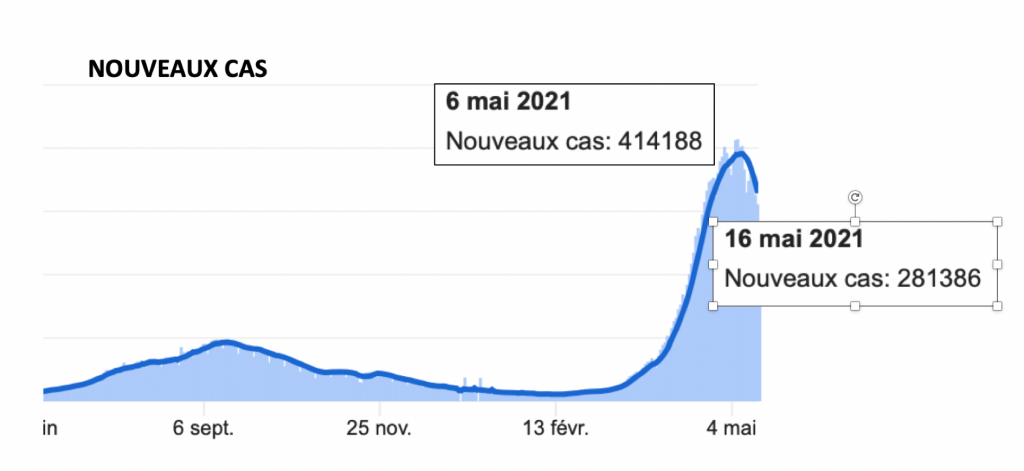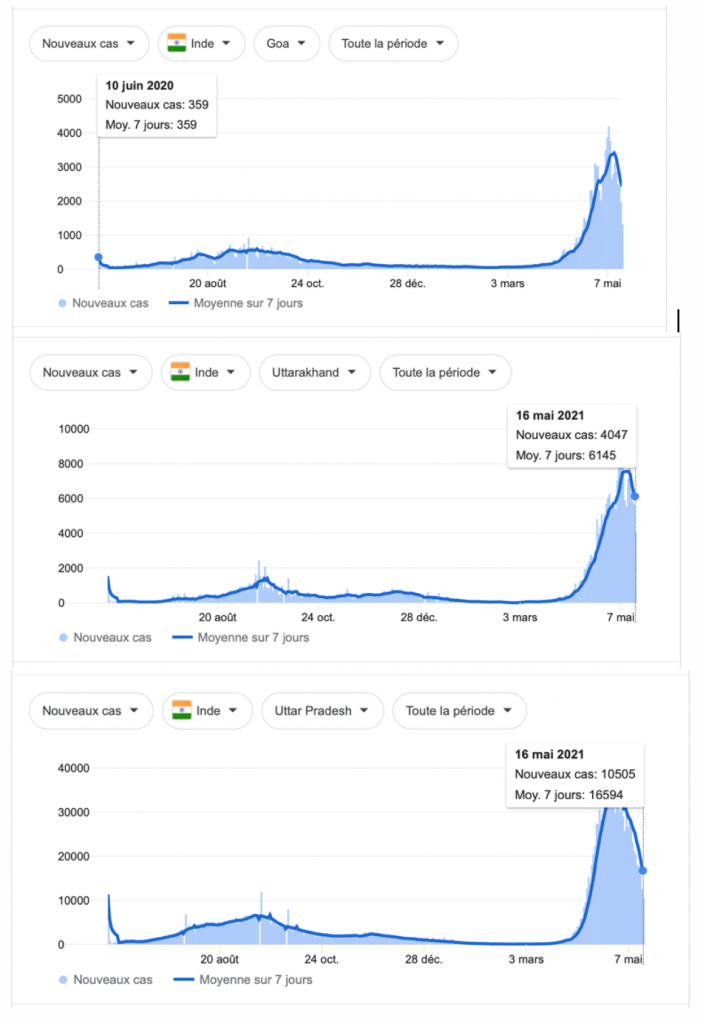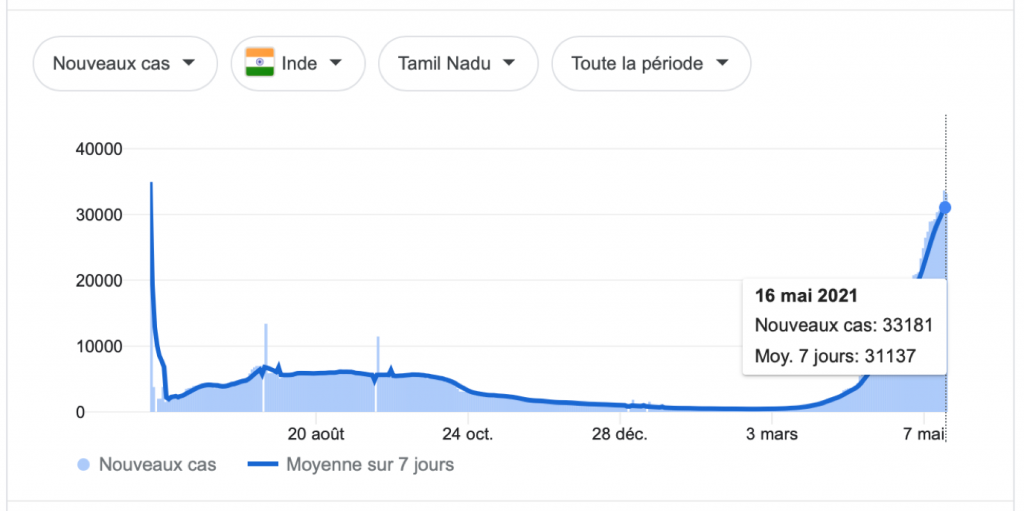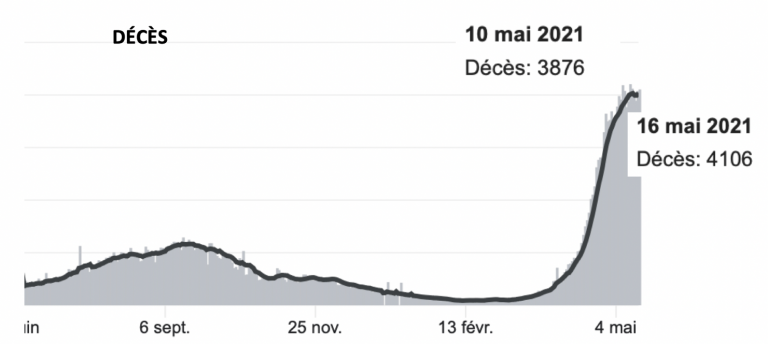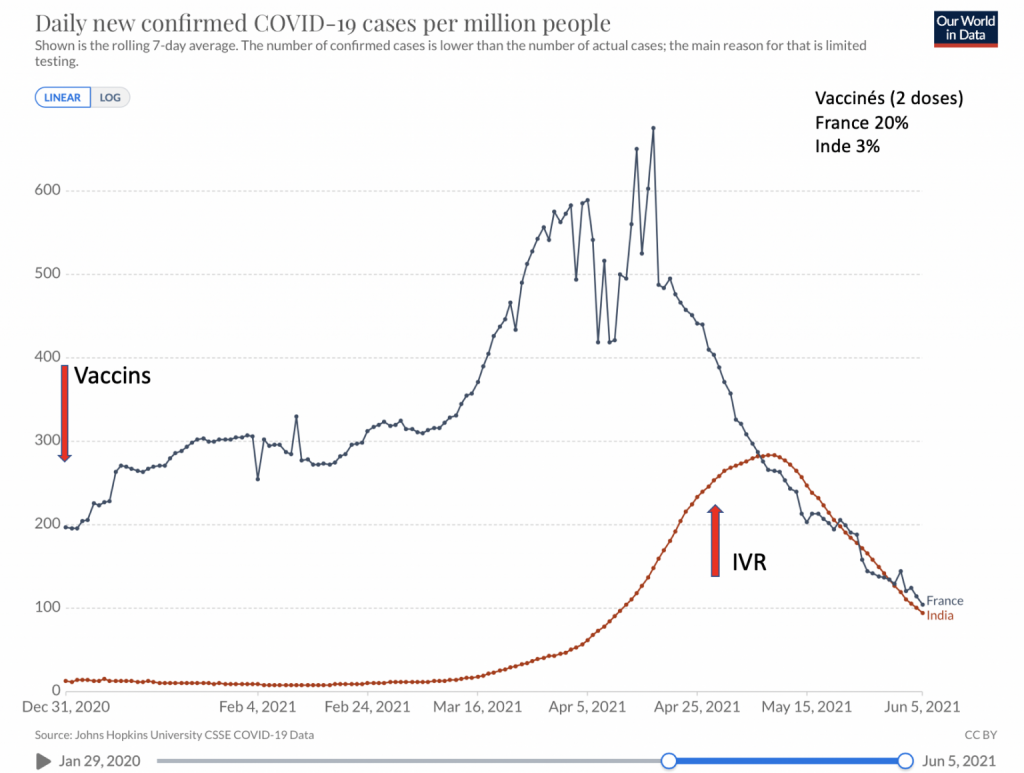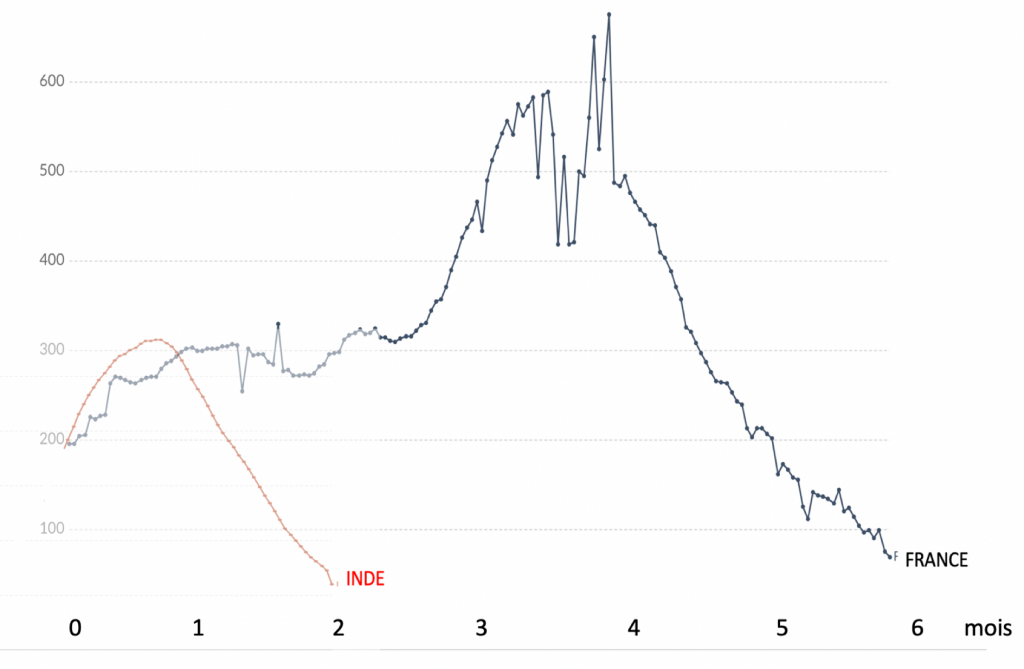Modified 22/6/21 to include the last month’s references to India, Covid and ivermectin
Much of this is Deepl translated
21/5/21:
Taken from The victories of ivermictin (the whole of which is in the entry for 21/5//21 here; the complete text compares India with France, Mexico, the Philipines, Portugal and South Africa)
By mid 2020, Uttar Pradesh in India was the first “country” (actually a state in India but with a population of 205 million, 3 times the size of France) to treat its population extensively with Ivermectin. Chiapas in Mexico did the same at about the same time.
In 2020, Uttar Pradesh had 7,800 deaths, compared to 65,000 here, which is 25 times less than us for the same population. A younger population, you may say, but the health conditions are much poorer, as we see today. Not all declared? Not to that extent! So to be fairer, let’s compare with another Indian state, like Delhi, which is 12 times less, and 3 times less than the country’s average. Same thing for Chiapas: with ivermectin, 4 times less deaths than the country average, 10 times less than Mexico City.
No one in the West was interested. Instead of seeing what was happening on a large scale, our authorities were quibbling about 2×12 studies, wondering whether they were published or not, whether the authors thought a few more guinea pigs were needed, without even looking at the results. Foolishness? Incompetence? Manipulation? I leave it to you to judge.
While 15 days ago everyone was talking about a catastrophe in India, a situation out of control, knowing that they had to deal with their second wave, I took the opposite view and calmed things down.
What about after 2 weeks? While our “great specialists” were still announcing a few days ago that India would not reach its peak of contamination before several weeks (repeated everywhere like here), here is the curve of the contaminations in India, up to date yesterday: it is eight days since the peak seems to have been reached.
How is this possible, so quickly, in a country where barely 3% of the population has had its two doses of vaccine so far? Many states have followed Uttar Pardesh. Goa followed (in 15 days reduction of 58% in hospitalisations), asking the whole population to take Ivermectin, then Uttarakhand and others.
What do the curves look like in these states?
But WHO and Big Pharma are watching. The WHO issued statements advising against Ivermectin, and Gilead showered the country with Remdesivir, even though it was advised against by the WHO, at a 20-fold price reduction. Some states followed the WHO, such as Tamil Nadu. Here is what it looks like: no decline. If you want all these curves day by day, type on Google “Covid India”, and you immediately have the curves of cases and deaths for all countries. For India, just to the right of the country, you can select each state. You can also find other curves on Patrice Gibertie’s website.
As far as deaths are concerned, given the 15-day lag with cases, when we were at 3000/day, I thought the peak would be between 5 and 6,000, it will be less because it seems to have plateaued at around 4,000 for the last week.
If this continues, the peak of the Indian “catastrophe” is at the level of what we have been experiencing on average for the last 6 months, and will have lasted only 10 days. Let’s remember that we had a peak of 1000 deaths in 24 hours, that is to say 20,000 in relation to their population. Having said that, let’s remember that with this virus, everything can change from one day to the next, but it seems to have taken hold in the last 8 days….
…It would seem that to stop a wave, ivermectin alone (less than 3% of those vaccinated with 2 doses in India, 1.5% in Zimbabwe, 1% in South Africa), goes much faster than vaccines alone. 15 days for the first, several months for the other. Also our vaccines seem to have problems with the Indian variant, whereas ivemectin does not.
Not treating Covid in its early stages is like an oncologist waiting for metastases before starting cancer treatment, like a surgeon waiting for sepsis and peritonitis before operating on appendicitis. This is the medicine we practice today.
24/5/21:
India: French report on shanty towns where everyone lives in close proximity mostly without masks and where Covid, or at least significant symptoms of it, is totally absent
This report largely explains this by the fact that in growing up people are exposed to lots of viruses and have developed a very powerful resistance to them.
***
Deepl translation without graphs of this: https://blog-gerard.maudrux.fr/2021/05/28/inde-covid-et-ivermectine-suite/
India: Covid and Ivermectin, continued.
Posted on 28 May 2021 by Gérard Maudrux
A month ago, all our “Covid specialists” and the press were rushing to India, like flies to vinegar. I had immediately taken the opposite view in a post on April 27, to explain that on the one hand their epidemiological situation (I’m not talking about their sanitary situation, which is bad, that’s another problem) was not worse than ours, on the contrary, and on the other hand I was saying that we had to wait a bit to see the result of the use of Ivermectin on a large scale, in the face of a powerful wave, of which it was said in France (as here) that the peak would not be reached for several weeks, whereas it had already passed!
Who was right? The alarmists? The defenders of Ivermectin? The result is there, resounding, indisputable. Yet not a word in the press, not a word from our specialists. No one wonders how the Indians, with fewer resources, have done ten times better than us. No one is trying to find out how to copy them or be inspired by them.
Here is the curve of new Covid cases in India, last updated on 27 May. You can see the peak of cases on the date I predicted, not after several weeks as announced, and then an extremely rapid drop. This drop is faster than their first wave, which was poorly treated, which was spread out but not as strong. And yet they have the Indian variant!
INDIA
When the governments of several states began to advise, or even distribute, Ivermectin, there was an offensive by the WHO, which issued communiqués saying that it did not advise Ivermectin, and by Gilead, which sprayed the country with Remdesivir at a derisory price without the international medical community being bothered, even though it knew that this drug was ineffective and dangerous. Ivermectin had to be countered.
The result is even more obvious when we compare the states that treat and those that do not, such as Tamil Nadu, which has decided to follow the WHO guidelines.
Here are the curves in states that treat extensively with ivermectin such as Uttar Pradesh, Uttarakhand and Delhi. The former went from 37,900 cases at peak to 3,100 cases, the latter from 9,600 to 2,800 cases, the latter from 28,400 to 1,500 cases. Other states such as Maharashtra, Rajasthan and Madhya Pradesh show the same scores, which are proportional to the importance of Ivermectin use.
In contrast, Tamil Nadu, which bans the treatment, was at 11,000 cases when the others were at their peak, and is now at 35,100 cases (it seems to have reached a plateau).
Even more telling is a summary curve:
It should be noted that these results concern several hundred million inhabitants (Uttar Pardesh is 3 times the size of France), and are only obtained with early treatment, in a country where only 3% of the population has received its two doses of vaccine.
In France, on the other hand, we are pleased that our second wave has ended, “thanks to vaccination”. The comparison of the curves and the decreasing slopes is eloquent: 6 months on one side versus 1 month on the other. Peak at 56,000 cases on 3 November, for 13,933 yesterday.
FRANCE
These Indian curves, their media treatment 1 month ago and now, these results, illustrate the great manipulation of the French opinion about the possible treatments for Covid.
I would like to take this opportunity to thank you for your reactions to the previous post, which touched me, and I hope that they will also have touched the Ordre des Médecins and will make it reflect on its attitude towards those who try to treat their patients. I repeat, we have an obligation of means, not necessarily of success. Not to try to treat, and especially to prevent others from trying to treat is unworthy of the profession, a fault, especially on the part of those who give lessons in deontology. They should also look at what doctors elsewhere are doing, and what their results are, results they don’t seem to want here.
As for your offers of help, thank you too. I did not accept because nothing will happen for a year, and if you invest today and nothing happens for months, you will wonder. We will talk about it again when the opportunity arises.
SF note:
Apparently ivermectin costs the state 10 euros for 15 kilos of the medicine. The daily dose per person depends on their weight – 0.2 milligrams per kilo. Which would, for someone weighing 80 kilos, cost the state (admittedly before packaging etc.) just 1.6 euros for 10,000 days’ supply (or, more rationally, less than half a cent for 30 days’ supply, or even more rationally – since you’re likely to recover after less than 10 days, 0.16 of a centime for 10 days) .
10/6/21:
Indian Minister of Health and Chairman of the WHO Executive Board, has decided on a total blackout on news about vaccines in India from today
“ It is forbidden to know what is going on with the vaccine: vaccination information “is the property of the central ministry and should not be shared with any other organization, partner agency, press agency, public online forums and offline ”.“
This article in French is mainly about ivermectin, and says this about India:
“Another miracle is the day after day confirmation of what happened in India, in the states which used Ivermectin, with very rapid resolution of a wave announced by all the media as a disaster that was going to wreak havoc, the media which has since been silent on what is happening. Total blackout. Uttar Pradesh has fallen to less than 1000 cases / day, population 3 times the size of France, which would make 300 cases here, at a time when we are happy to go below 5,000 cases / day! Ditto in states like Delhi and Goa. These 3 states have reduced the cases by 98% compared to the peak at the end of April (37,000 cases for Uttar Pradesh, 28,000 for Delhi).
Since then there has been war in this country between the various national medical authorities under pressure from the WHO and Merck, with press releases authorizing or banning ivermectin. They have gone mad to see these results, but the responsible states do not budge and maintain their position. The Ministry of Health, after authorizing in a protocol, wants to now ban all early treatment. It should be noted in passing that the Minister of Health has been President of the WHO Executive Boardsince May 2020, and that the WHO immediately issued statements to advise against Ivermectin from the start of treatment, a complaint has also been made. filed on this subject, non-assistance to a person in danger is characterized. We then received a statement from the WHO congratulating itself on having intervened in this state to reduce the epidemic, by supervising 2,000 teams and distributing treatment kits, being careful not to say what was in them. Ivermectin, of course, but this product does not exist for the WHO. And more recently, we were treated to another victory press releaseafter the supposed ban (not yet very clear). The WHO, which congratulates itself when we do not give treatment, welcomes the ban on the treatments it has distributed. Incredible !
Finally, a quick comparison between a country that uses ivermectin, and a country that refuses it so as not to interfere with its vaccination campaign.
The figures are from Johns Hopkins University, they are the daily figures averaged over 7 days to avoid weekend breaks. These figures are reported per million inhabitants, to compare 2 countries with unequal populations. We can also see that the Indian wave, as I said since the first day, is much lower in intensity than what France was experiencing. We also see that ivermectin worked well on the Indian variant. Finally, some will tell you that the Indian figures are understated; if this is the case, it is of no importance here to follow an evolution over several months, the collection conditions being the same over the entire period. “
Apparently ivermectin costs the state 10 euros for 15 kilos of the medicine. The daily dose per person depends on their weight – 0.2 milligrams per kilo. Which would, for someone weighing 80 kilos, cost the state (admittedly before packaging etc.) just 1.6 euros for 10,000 days’ supply (or, more rationally, less than half a cent for 30 days’ supply or, even more logically since the disease can be cured in considerably less than 30 days, 0.16 cents for 10 days) . Ivermectin was discovered and developed by Satoshi Omurai who received a Nobel prize for it in 2015.
17/6/21:
Ivermectin, India and demystification
Rough translation:
Ivermectin, India and demystification.
Posted on 17 June 2021 by Gérard Maudrux
What is annoying with the press is that when there are many cases they’re made into headlines, and after having built up the suspense, nothing more, we never get the denouement. It’s the same with Covid in India: they all get into it, they build up the pressure announcing “chaos, an epidemic out of control, India brought to its knees by Covid,…”, then now that the problem is solved, nothing more. There’s no mention of it, no mention of what happened, no desire to mention what happened.
A newspaper was launched, not to say what happened, but to deny what happened, in line with the official discourse: “ivermectin doesn’t work”, we have to anticipate so that some people can’t say it, and if it works on ivermectin, it means that there is something else underneath. On 10 June 2021, it was Le Figaro that opened the ball of disinformation, not to say revisionism.
The headline: “Has ivermectin enabled India to break the epidemic wave? “The sub-heading says: “Verification. Some people credit this drug with improving the health situation in India. Yet it is not recommended by international health authorities. What about it?” No one in the press has talked about it in an investigative journalistic way, and already journalists are beginning to contradict what is being said here and there. What are their arguments for denying the evidence or, at the very least, a hint of presumed effectiveness of ivermectin?
Yet the article in Le Figaro begins well: “In mid-March the pace quickens, at the end of April, in the middle of the storm, the Ministry and the health authorities include ivermectin in the treatment, and at the beginning of May, the number of daily cases begins to decrease”. We agree.
Then they go on to say, “this temporary correlation is not proof that ivermectin is effective”. Proof? Same rhetoric last year for hydroxychloroquine, which India has never stopped recommending. Then they cite Peru. And then “ivermectin is not recommended to prevent infection, and even if it worked, it would not reduce the number of new cases. Logically, therefore, the decline in cases in India cannot be attributed to the presumed effectiveness of this drug.” What logic? Reverse logic? What faulty reasoning, what epidemiological ignorance! If you distribute to all the sick, all the contact cases, all the population (like the state of Goa), there is no more active virus to transmit and therefore the epidemic ends.
“Note that the rate of reproduction of the epidemic had begun to decline even before ivermectin was recognised as a treatment by the Indian government.” But why didn’t they say so in the first place, since they knew the epidemic would decline? Why did they panic the world, why did they write that it would take many months, when the wave had ended before it began? This is WRONG, dead wrong. Firstly, this is not to mention that many Indian states did not care about the government’s decisions, they anticipated, and the government followed, not the other way round. Then: 379,000 cases on 28 April, the date cited by Le Figaro, peaking 10 days later at 410,000 cases. It was only on 9 May that the decline really began. Finally, journalists doubt the figures given by India, but when it suits them, they do not doubt their R0 (reproduction rate)!
And then, for lack of arguments, in order not to talk about India, they go back to the “poorly done studies”, to the in vitro study dear to Castafiore and Inserm, and the French Society of Pharmacology, they just forgot to quote the magazine Prescrire, to show that it doesn’t work in India! It didn’t work, because our “scientists” said it couldn’t work.
So why were the results in India so much better than here? Le Figaro obviously has some unquestionable explanations. “Two main elements can explain it. Since April several states have confined, and India has considerably increased the pace of vaccination. “We are being taken for fools, you are really being taken for fools, by putting forward vaccination as the cause of the epidemic downfall in India, a country where 3% of the population had received two doses. With our vaccination figures, 6 times higher (3% and 17% of the population, Le Figaro speaking of absolute values, ignoring the fact that India is 20 times more populated), I don’t understand why we have so many new cases, and why we haven’t gone negative! As for confinement in a poor and overpopulated country such as India, I have some doubts about its rigour and effectiveness. France has combined these two causes put forward by the Figaro (containment and vaccination), without using ivermectin. I’ll give you the result in pictures, it’s clear, except for those who don’t want to see.
Curve: Cases/day/million inhabitants, with identical starting point at 195 cases per day. India’s position is unfavourable because the epidemic is growing, France is pseudo-stable. India lockdown + ivermectin, vaccines 3%, France lockdown + vaccines 17% (2 dose vaccines, 1 June).
The icing on the cake, the height of journalistic stupidity that thinks it is addressing other fools (us): “the ultimate proof, if any were needed, that ivermectin has nothing to do with the improvement of the health situation in India: the Indian Minister of Health published new recommendations on 7 June… without ivermectin”. No, gentlemen of the Figaro (a lady in this case), the effectiveness or ineffectiveness of ivermectin cannot be decreed. The proof? We recommend Doliprane, but that doesn’t mean it works! This is exactly what the Figaro is demonstrating. No credible argument in this article, but they affirm, and the one who argues against it is called a conspiracy theorist.
